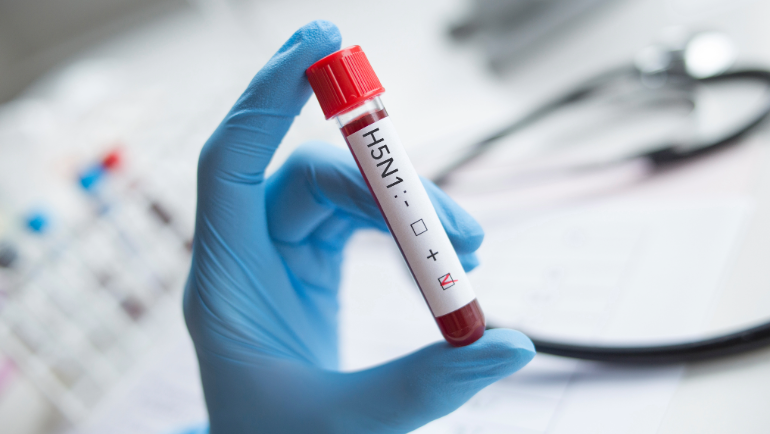Wayne State University experts discuss recent avian influenza H5N1 developments and potential implications

DETROIT – A confirmed human case of a highly pathogenic avian influenza (HPAI) A(H5N1) virus in Texas, along with the detection of the virus in dairy cattle, has raised concerns among public health experts. The infected individual, a farm worker in Texas, contracted the virus after exposure to infected dairy cattle, marking the first known case of avian-to-bovine-to-human transmission in the United States. The infected individual is being treated and is recovering.
“The transmission of H5N1 from birds to cattle and the subsequent human infection underscore the importance of robust surveillance and monitoring systems,” said Paul Kilgore, M.D., M.P.H., F.A.C.P., a medical epidemiologist and professor of pharmacy practice in Wayne State University’s Eugene Applebaum College of Pharmacy and Health Sciences and co-director of Wayne State’s Center for Emerging and Infectious Diseases (CEID). “As the virus adapts to new hosts, the potential for further spread and the emergence of novel strains increases.”
Infectious disease specialists Marcus Zervos, M.D., clinical professor of internal medicine in the Wayne State University School of Medicine and division head of infectious diseases for the Henry Ford Health System, and Teena Chopra, M.D., M.P.H., professor of medicine in the Wayne State University School of Medicine, both co-directors of CEID, emphasize the need for heightened vigilance and preparedness in states with significant agricultural sectors, including Michigan.
“The agricultural industry plays a vital role in Michigan’s economy, and it is crucial that we take proactive measures to protect both animal and human health,” said Zervos.
Chopra added, “Collaboration between public health officials, veterinary experts and the agricultural community is essential to prevent and mitigate the impact of avian influenza outbreaks.”
The A(H5N1) virus is a zoonotic disease, which is disease the jumps from an animal host to humans. These diseases, including M. Pox and COVID-19, can be concerning because of the unknown impact on human health. The U.S. Centers for Disease Control and Prevention suggests that “people with close or prolonged, unprotected exposures to infected birds or other animals — including livestock — or to environments contaminated by infected birds or other animals are at greater risk of infection.”
Matthew Seeger, Ph.D., a risk communication expert; distinguished professor of communication in Wayne State’s College of Fine, Performing and Communication Arts; and co-director of CEID, highlights the importance of clear and consistent communication during this evolving situation.
“Transparent, timely and accurate information is key to maintaining public trust and ensuring that appropriate precautions are taken,” said Seeger. “It is essential that public health agencies, government officials and industry leaders work together to develop and disseminate evidence-based guidance to all stakeholders.”
A comprehensive, coordinated and carefully planned public health surveillance strategy is crucial in responding to the current avian influenza situation. This should include genomic analysis of circulating H5N1 strains to monitor for potential mutations and the emergence of new avian influenza strains among birds and mammals. By closely tracking the virus’s evolution and spread, public health officials can make informed decisions and implement effective control measures to protect both animal and human populations.
“The Center for Emerging and Infectious Diseases is a national leader for advancing research, education and public health initiatives to address the challenges posed by avian influenza and other emerging infectious diseases,” said Ezemenari Obasi, Ph.D., vice president for research at Wayne State. “Their important work will guide informed decision-making for creating and utilizing proven tools that enhance preparedness and protect communities from diseases of epidemic and pandemic potential."
Chopra, Kilgore, Seeger and Zervos are available to provide further insights and guidance as the situation develops.
###
About the Center for Emerging and Infectious Diseases
The Center for Emerging and Infectious Diseases at Wayne State University aims to develop, evaluate and implement effective countermeasures against existing and emerging infectious disease threats by conducting research in its state-of-the-art microbiology laboratory. The Center enables rapid implementation of research teams to prepare clinical vaccine trials and related interventions in outpatient, inpatient and community settings that can ultimately impact the health of citizens of Detroit, Michigan and ultimately around the world. For more information, visit ceid.med.wayne.edu.
About Wayne State University
Wayne State University is one of the nation’s pre-eminent public research universities in an urban setting. Through its multidisciplinary approach to research and education, and its ongoing collaboration with government, industry and other institutions, the university seeks to enhance economic growth and improve the quality of life in the city of Detroit, state of Michigan and throughout the world. For more information about research at Wayne State University, visit research.wayne.edu.
Contact info
Julie O'Connor
Director, Research Communications
Phone: 313-577-8845
Email: julie.oconnor@wayne.edu